The Following was issued by the Severe Winter Europe Discussing the Upcoming Strong Stratospheric Warming Which Will Affect the Northern Hemisphere.
Early signs show a Major Shift in the Polar Vortex, with a Strong Stratospheric Warming Wave now likely to bring a more Wintry Weather pattern in January
A strong Stratospheric Warming event is starting to appear in the forecast for January. It means a weakening or even collapse of the Polar Vortex and could bring a much-expected weather pattern change across the United States and Europe as we head deeper into Winter.
We already discussed a major January weather pattern shift in our recent articles. But we never really got an in-depth look at all the mechanics behind a strong weather shift across the United States.
In this article, we will look at the stratospheric Polar Vortex, one of the main culprits behind mid-winter weather pattern shifts. We will quickly look at what it actually is before focusing on the upcoming stratospheric warming event and potential winter weather outcomes in early January.
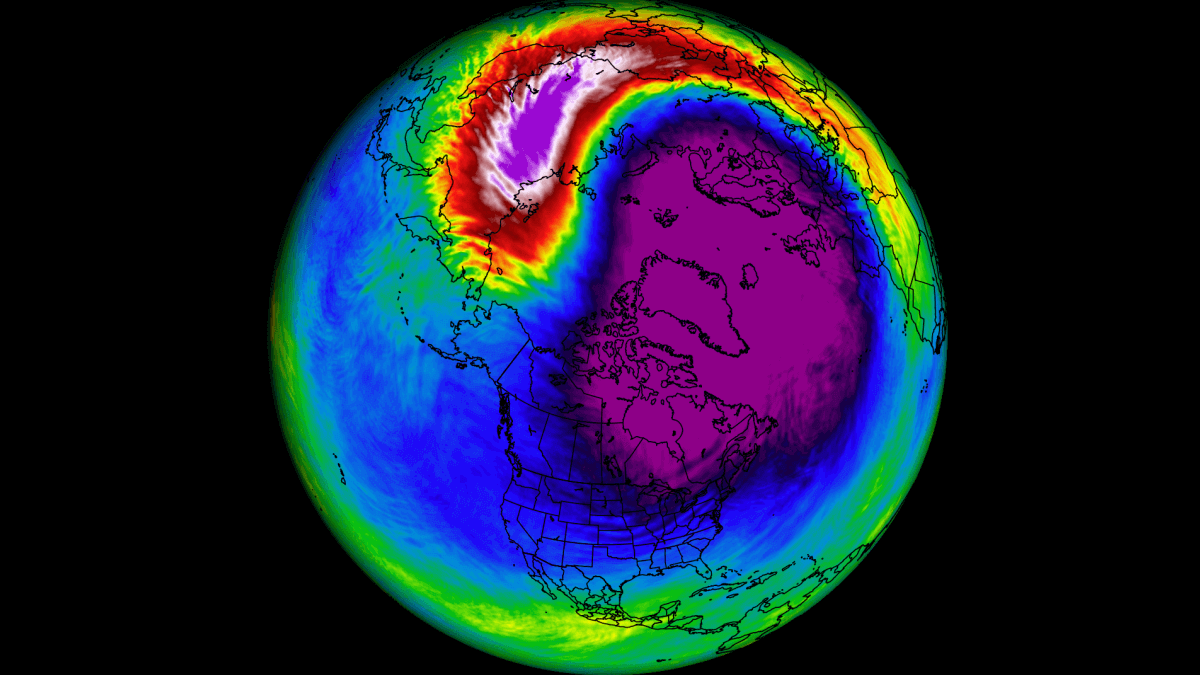
POLAR VORTEX OVER THE NORTH
The best way to understand the Polar Vortex is to visualize it. In
simple terms, it is just a name that describes the broad winter
circulation over the northern (and southern) hemispheres.
Below, you can see a 3-dimensional image of the Polar Vortex. The vertical axis is greatly enhanced for better visual presentation. It basically shows the actual structure of the Polar Vortex, connecting down to the lower levels and to the pressure systems.
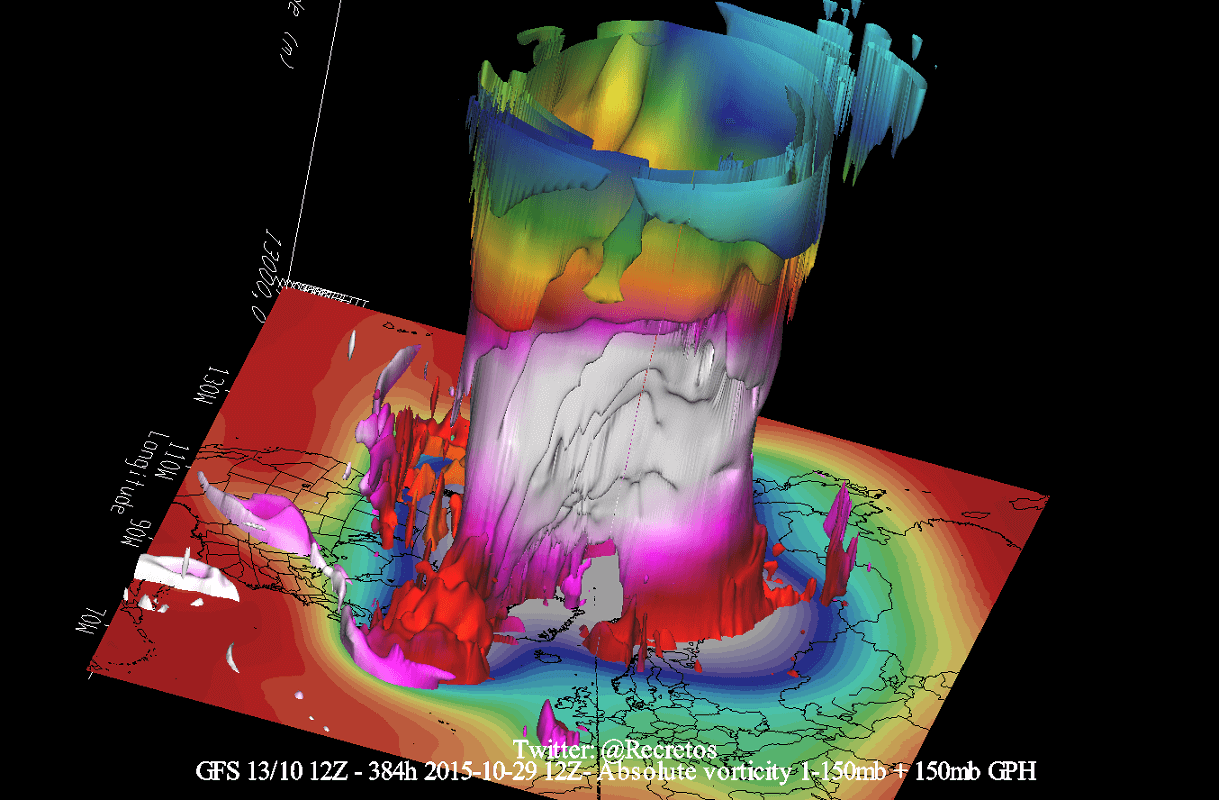
The Polar Vortex extends high up into the atmosphere. The lowest level of the atmosphere is called the troposphere, where all the weather events are. But above that, we have the stratosphere, a deeper and drier layer, and the home of the ozone layer.
For this reason, we tend to separate the entire Polar Vortex into an upper (stratospheric) and a lower (tropospheric) part. They both play their role differently, so we monitor them separately. But both parts together form the winter circulation across the Northern Hemisphere.
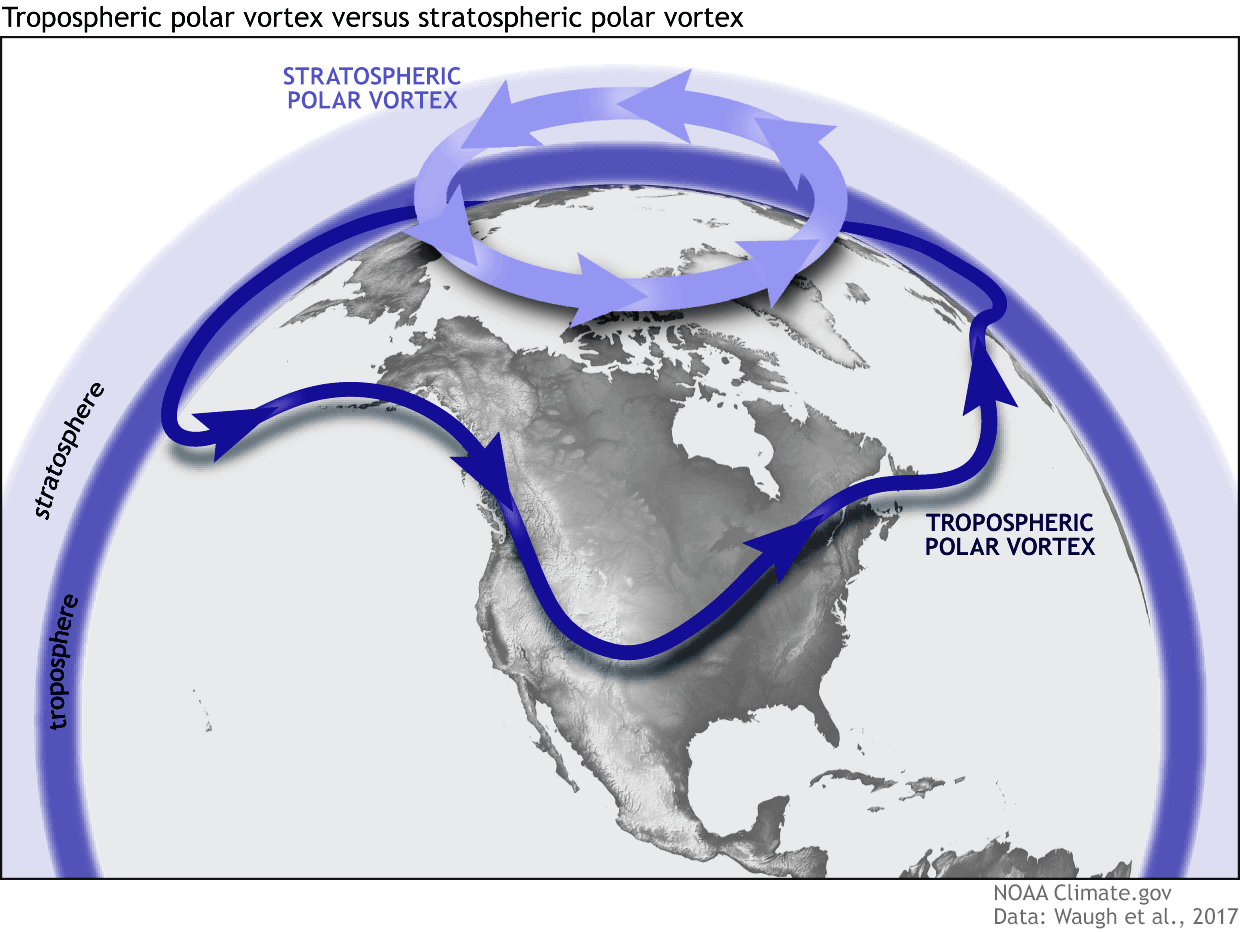
To put the Polar Vortex into perspective, we produced a high-resolution video below, which shows the Polar Vortex in 3D, giving you a better idea of what it actually looks like. But note that the vertical size of the vortex was greatly enhanced for visual purposes.
The main takeaway from the video should be that the Polar Vortex is not
just one winter storm or a cold outbreak that moves from the Midwest
into the eastern United States. It is the entire weather circulation
over the Northern Hemisphere.
Now that we know what the polar vortex is, we will look at the latest
analysis, the forecast for the near future, and also at the
extended-range forecast of weather patterns.
CURRENT STATE OF THE POLAR VORTEX
The Polar Vortex is currently normal in size, but it is displaced due to
a high-pressure area over the North Pacific. The image below shows
geopotential height and temperature in the mid-stratosphere at the 10mb
level (30km/18.5miles). The Polar Vortex looks like a “cyclone” with a
cold core near its low-pressure center. Image by weatheriscool.com
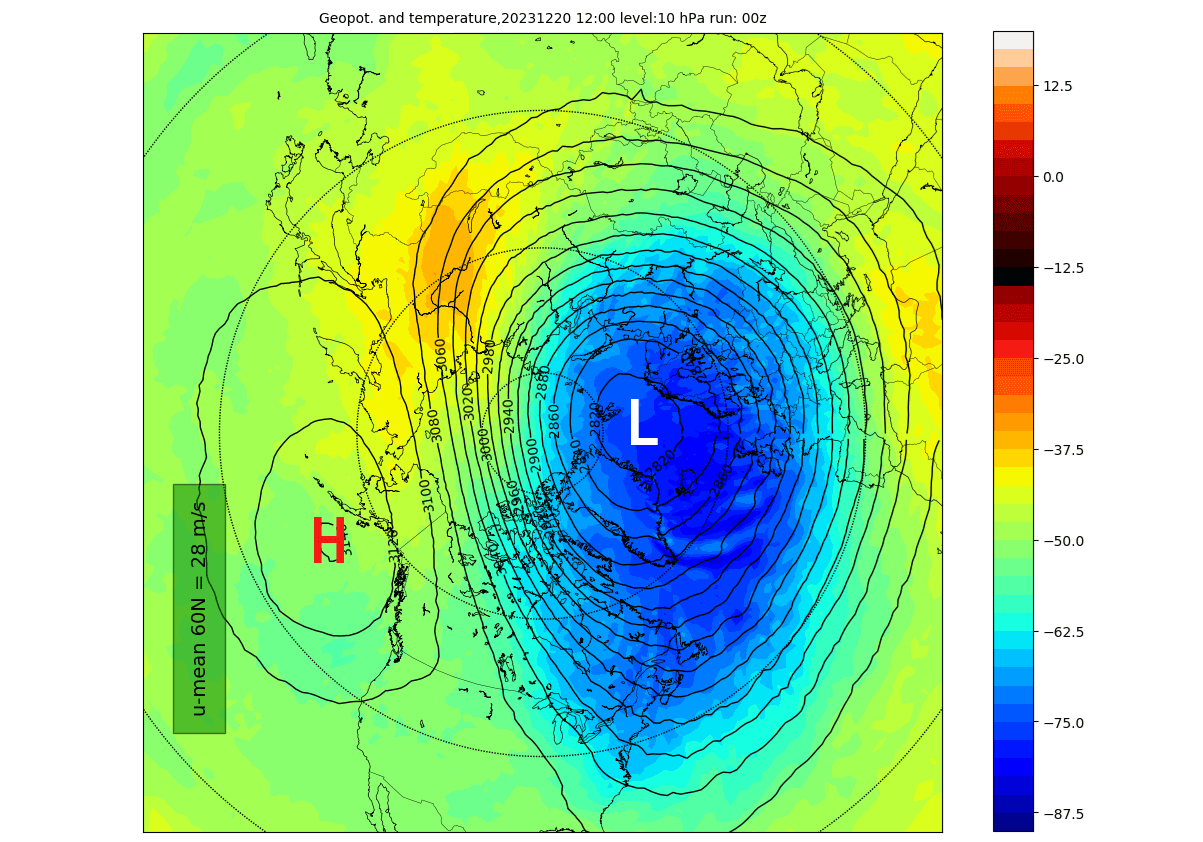
You can see a weak, warm wave on the border between the pressure systems. This is only a small warming wave, with a stronger event expected to develop.
If we look at the 3D structure of the whole Polar Vortex, we can fully see the current compact structure of the Polar Vortex. It is not circular in shape but rather elongated and compressed. That is because a stratospheric high-pressure area is pressing against it.
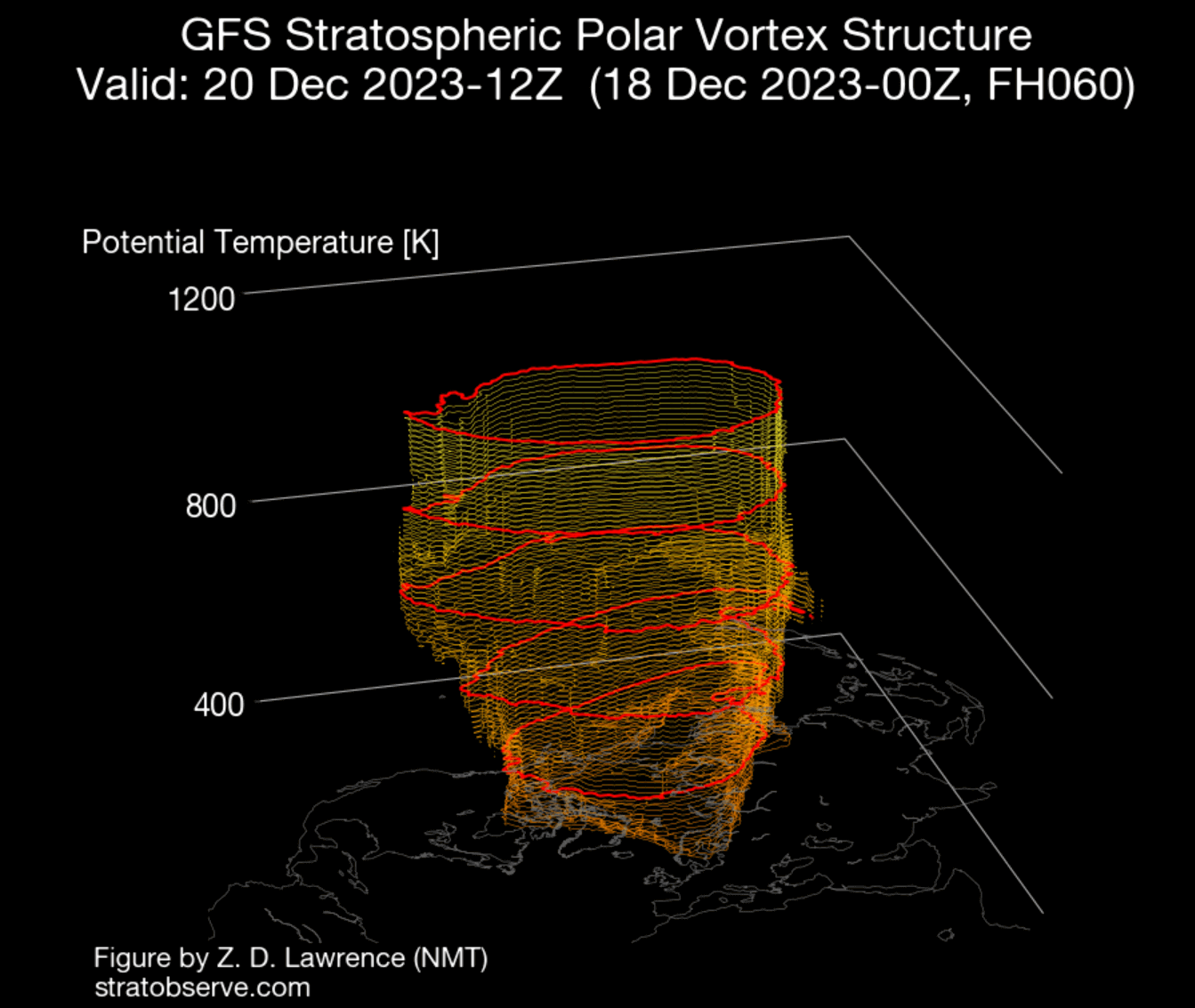
The vertical pressure anomaly structure can directly reveal the connection between the stratospheric polar vortex and the lower levels.
Below is the vertical pressure analysis from the ground up to the top of the stratosphere (45km/28 miles). You can see the strong negative anomalies over Greenland and the polar regions, connected all the way to the surface levels. The strong low-pressure anomaly above is the core of the polar vortex.
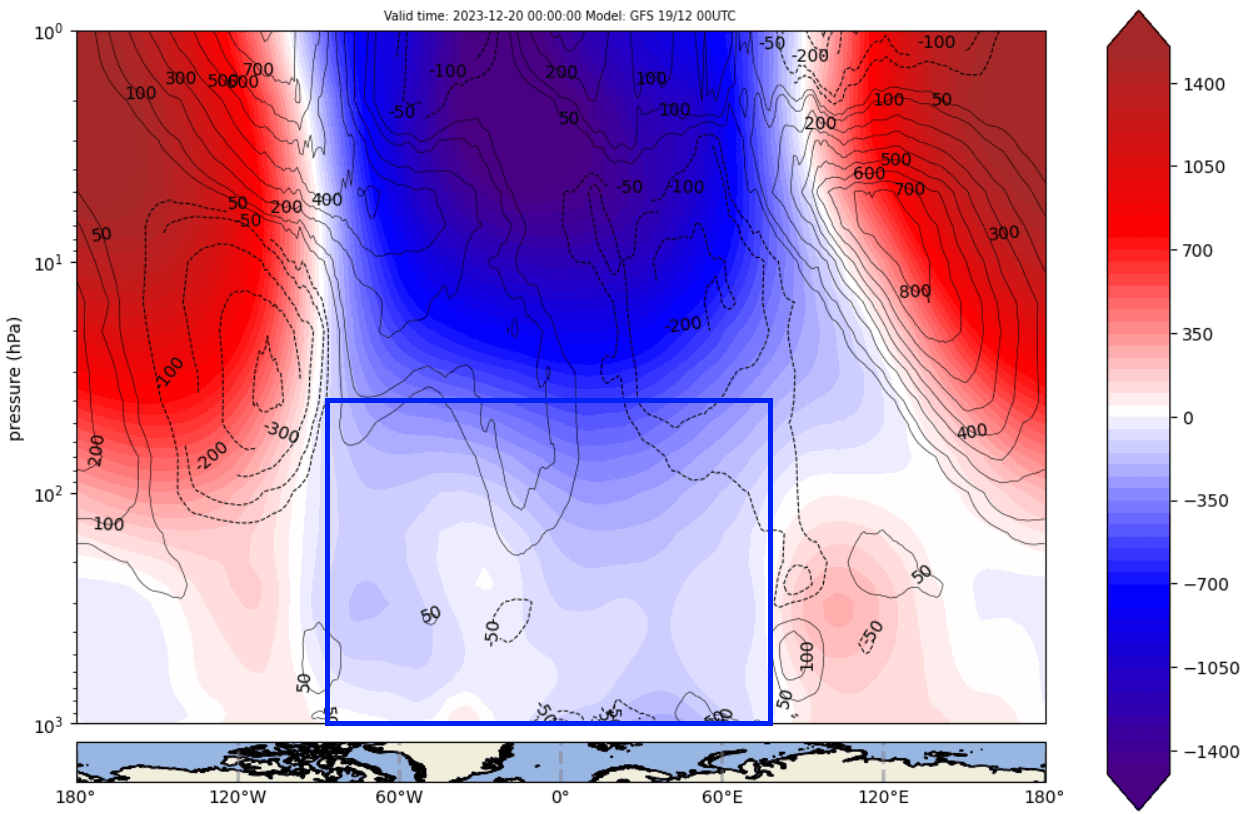
You can also see the high-pressure anomaly surrounding the polar vortex over the entire stratospheric level. This is what is pressing against the polar vortex, also affecting its structure and the weather at lower levels.
This can be seen in the weather pattern analysis below. It shows the pressure anomalies across the Northern Hemisphere. You can see the concentrated low-pressure area over the polar regions, which is acting like the “foot” of the stratospheric polar vortex.
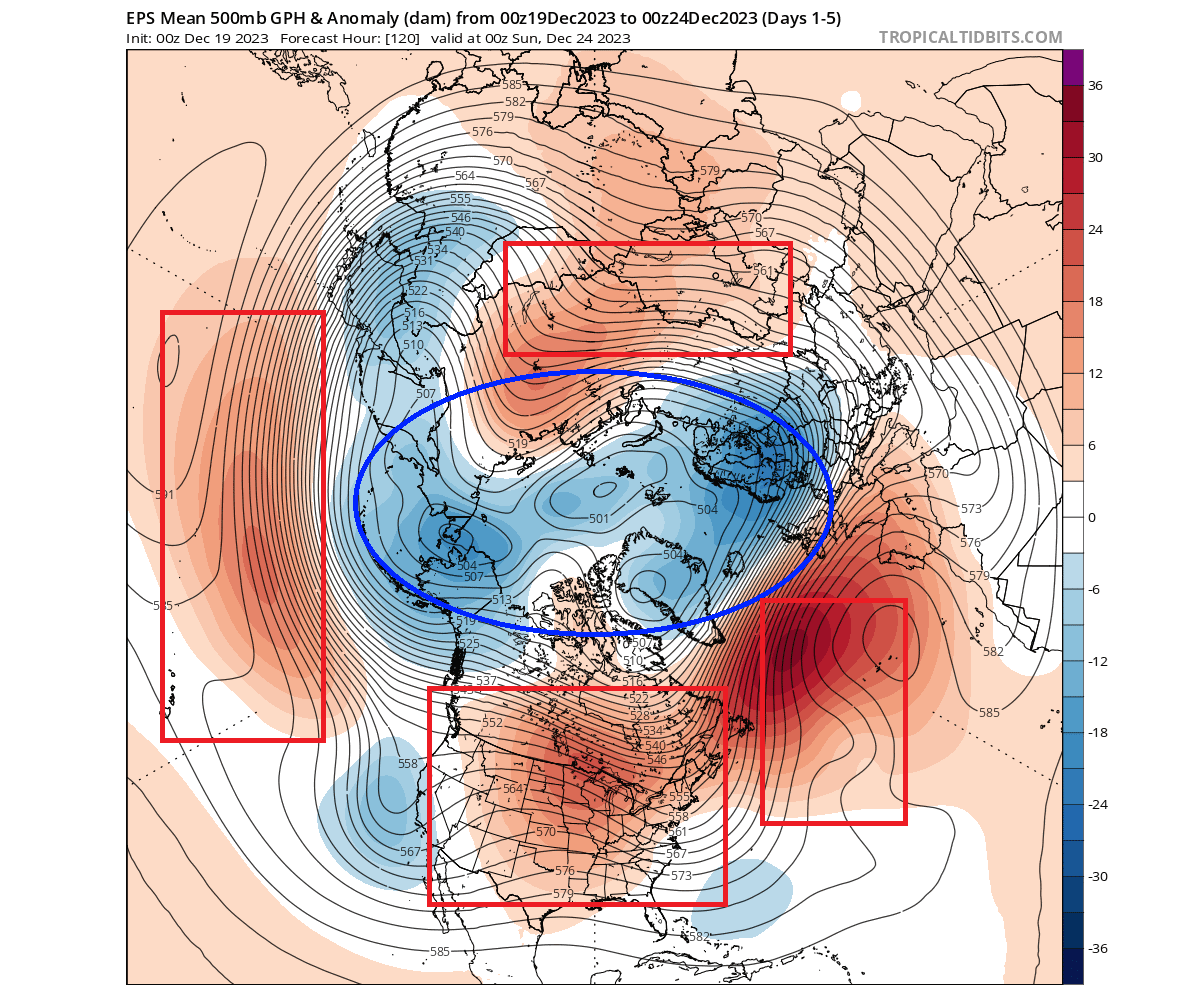
That, of course, affects the temperatures around the northern hemisphere. With a “locked-in” low pressure are over the poles, the colder air has a hard time to escape. That allows the unusually warm air to enter the mid-latitudes, creating warmer anomalies across the United States and Europe.
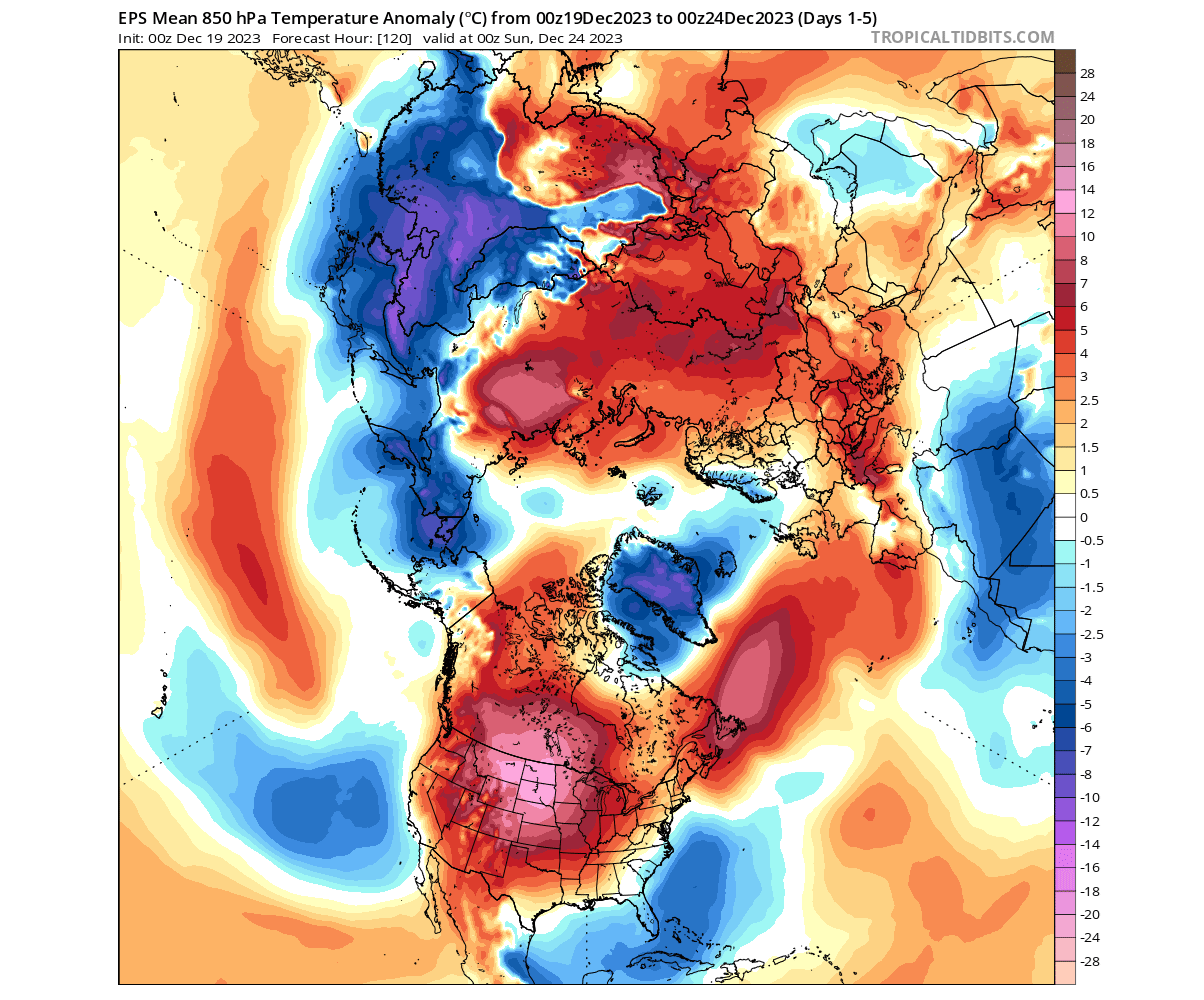
The reason we showed you this is to reveal the connection and importance of the stratospheric polar vortex and its link with the weather at the surface.
It is very important that we monitor the state of the Polar Vortex, as it can have a profound impact on our daily weather. We mainly separate the Polar Vortex into two different modes:
A strong/stable Polar Vortex usually means strong polar circulation and jet stream. This contains the colder air into the Arctic Circle, creating milder conditions for most of the United States.
In contrast, a weak/disrupted Polar Vortex creates a weak jet stream pattern. As a result, it has a harder time containing the cold air, which can now escape from the polar regions into the United States or Europe. Image by NOAA.
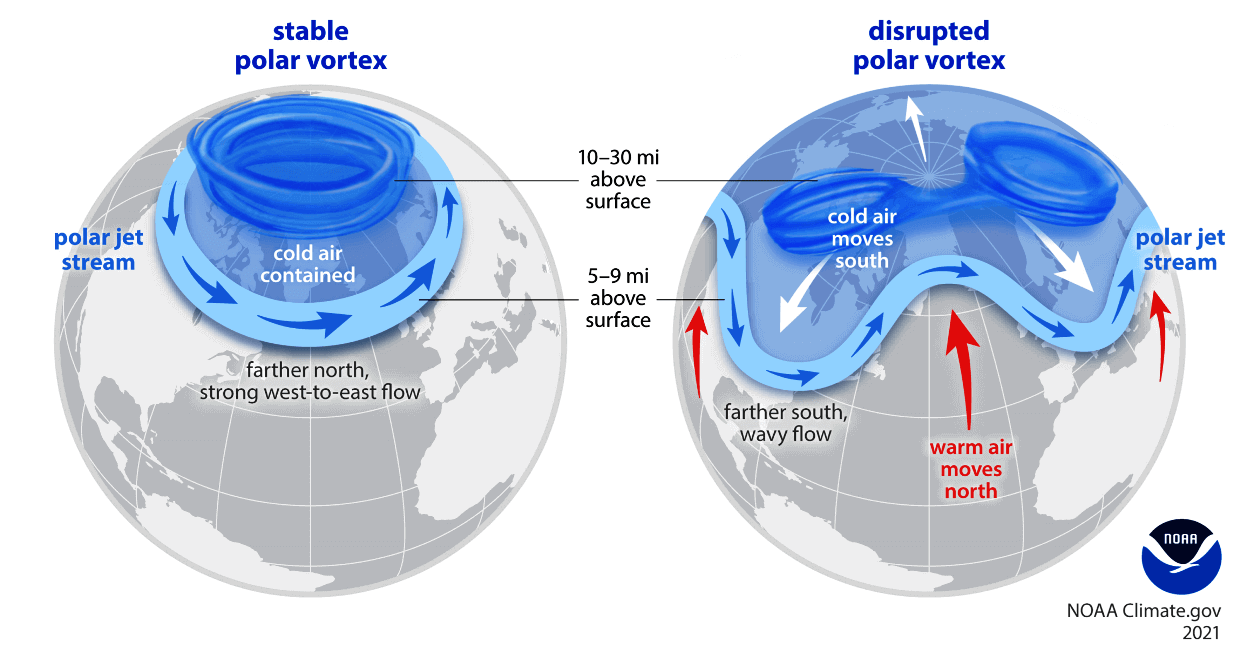
So, if you want cold and snow during Winter, and you live in the central or eastern United States, your odds are highest with a weak Polar Vortex. In nature, that means a heavy disruption of the jet stream and a release of cold air from the polar regions.
For this reason, we closely monitor the strength of the polar vortex
and all the changes around it. This is even more important when there
are sudden changes in the strength of the polar vortex, with potential
warming events.
THE WINDS OF CHANGE
But how do we measure the strength of the stratospheric Polar Vortex?
The simple answer is the winds. The more organized the stratospheric
polar Vortex is, the stronger the winds inside it, which means it can
have a stronger influence on the surface.
The image below shows the wind analysis and forecast for the next two weeks in the mid-stratosphere. You can see the current state of the polar vortex in the blue zone. It was fairly stable and average in strength. But notice the upcoming weakening in the coming days.
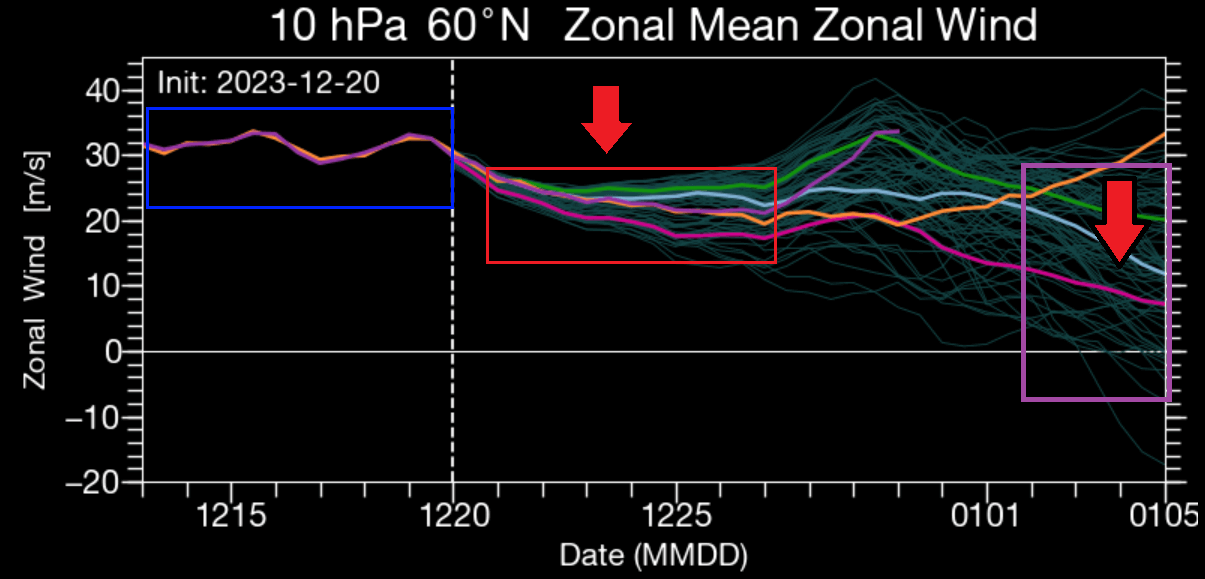
After that, there is a slight recovery, but going into 2024, an even stronger weakening is forecast, that might lead to something bigger. When the zonal (westerly) westerly winds in the stratosphere reach zero or negative values, it means a circulation reverse.
This signals a disruption or even a breakdown of the stratospheric polar vortex, known as the Sudden Stratospheric Warming event. These effects usually transfer down to the lower levels, with some delay, heavily altering the weather patterns.
The temperature forecast for the stratosphere shows a strong rise in temperatures going into 2024. Combined with a reduction in westerly wind speeds, it indicates a major slowdown of the polar vortex, combined with a warming event.
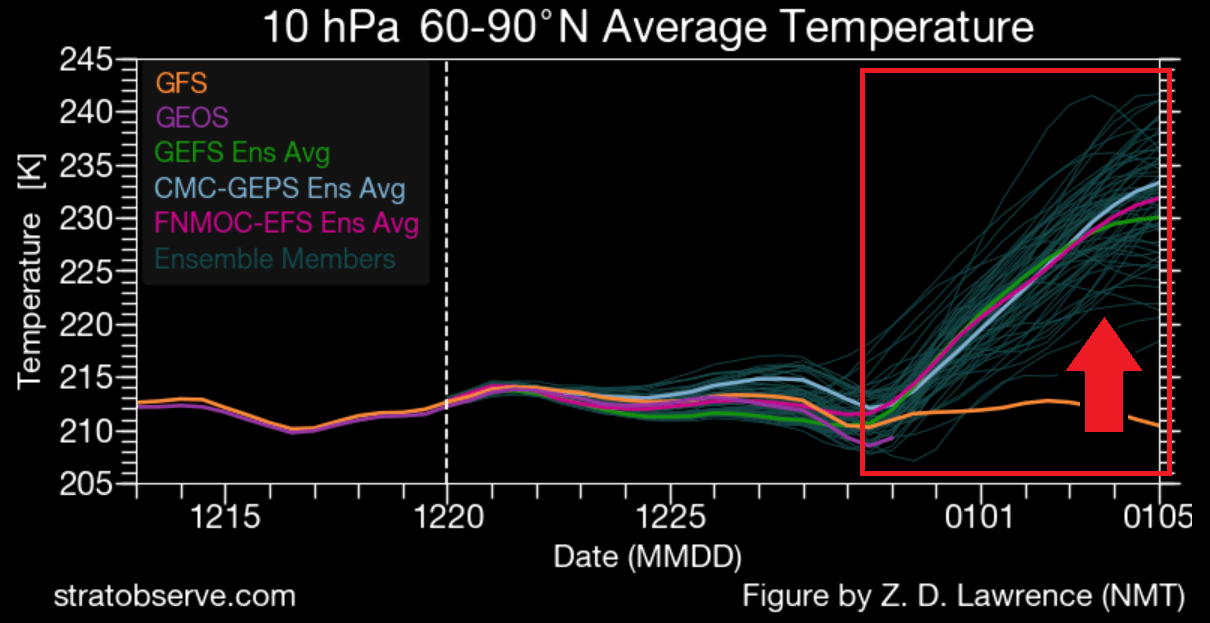
Another model that we often look at is the ECMWF, and it also has an extended forecast. You can see it in the image below, and it shows a very strong polar vortex slowdown in early January. The average line is close to zero, indicating a strong tendency of a full polar vortex collapse event.
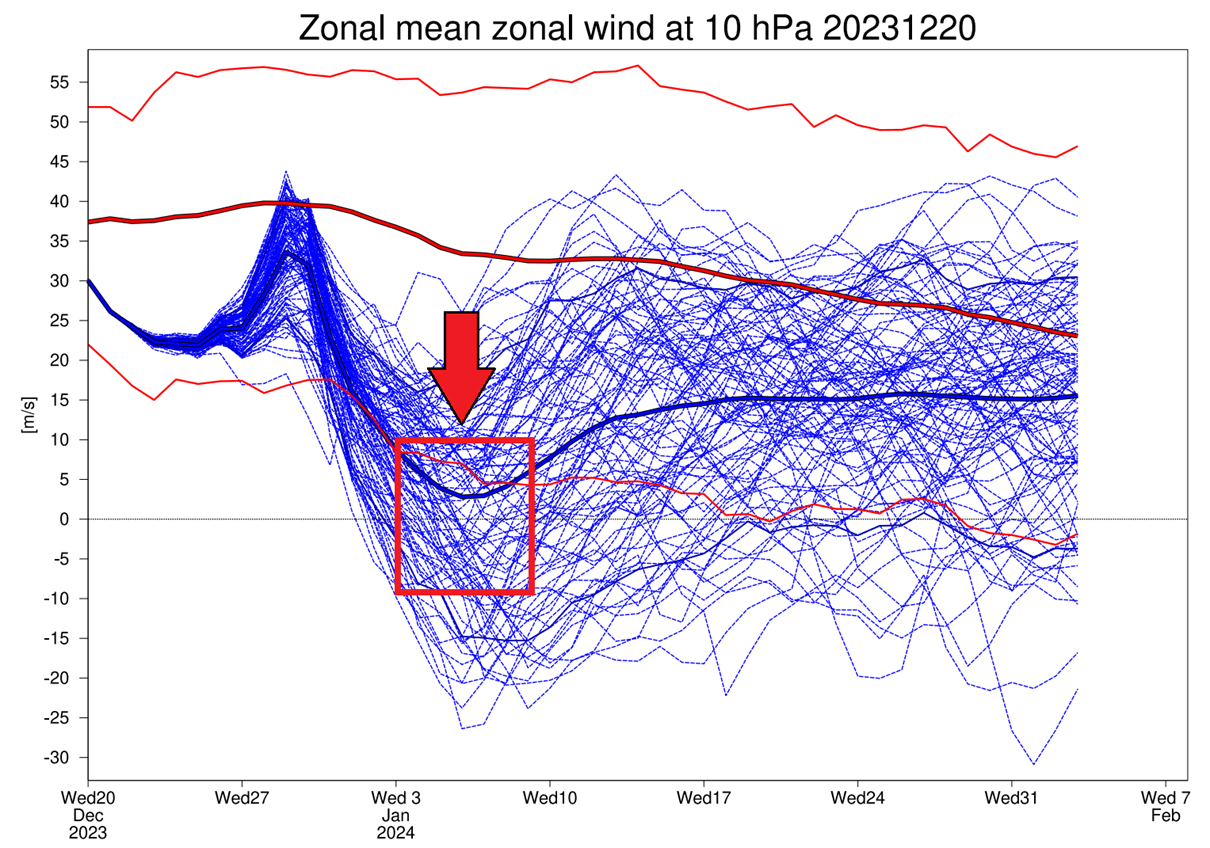
If we look at the polar vortex forecast in the early days of January, we can see a very strong high-pressure area in the stratosphere, sometimes called the “anti-vortex”. You can see a very strong warming wave occurring where they come together.
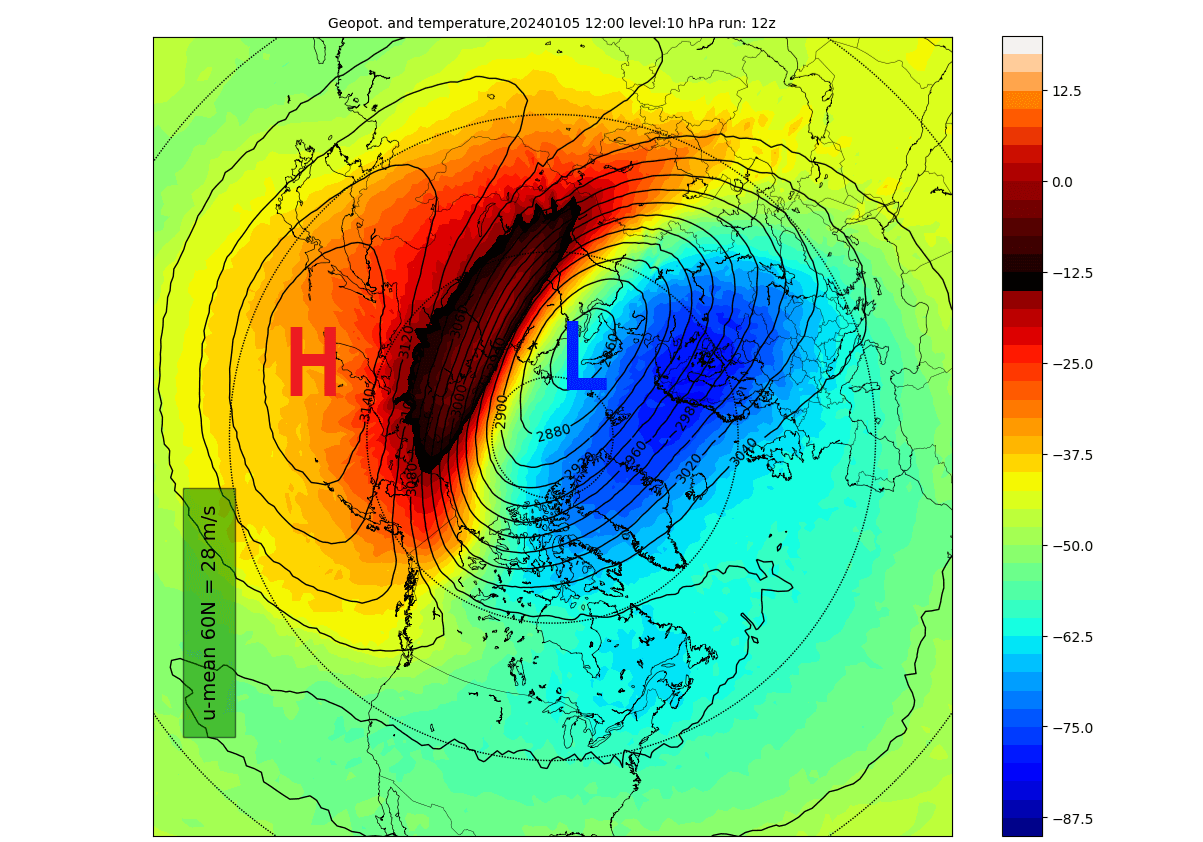
That is the start of a substantial stratospheric warming event and an important weakening for this time of year. But how does such an abrupt weakening of the Polar Vortex even happen? We will look more closely at this event and how it can change our daily weather.
The ECMWF model shows the same pattern for the first week of January. You can see it in the image below. A strong stratospheric high-pressure area and a substantial warming wave anomaly.
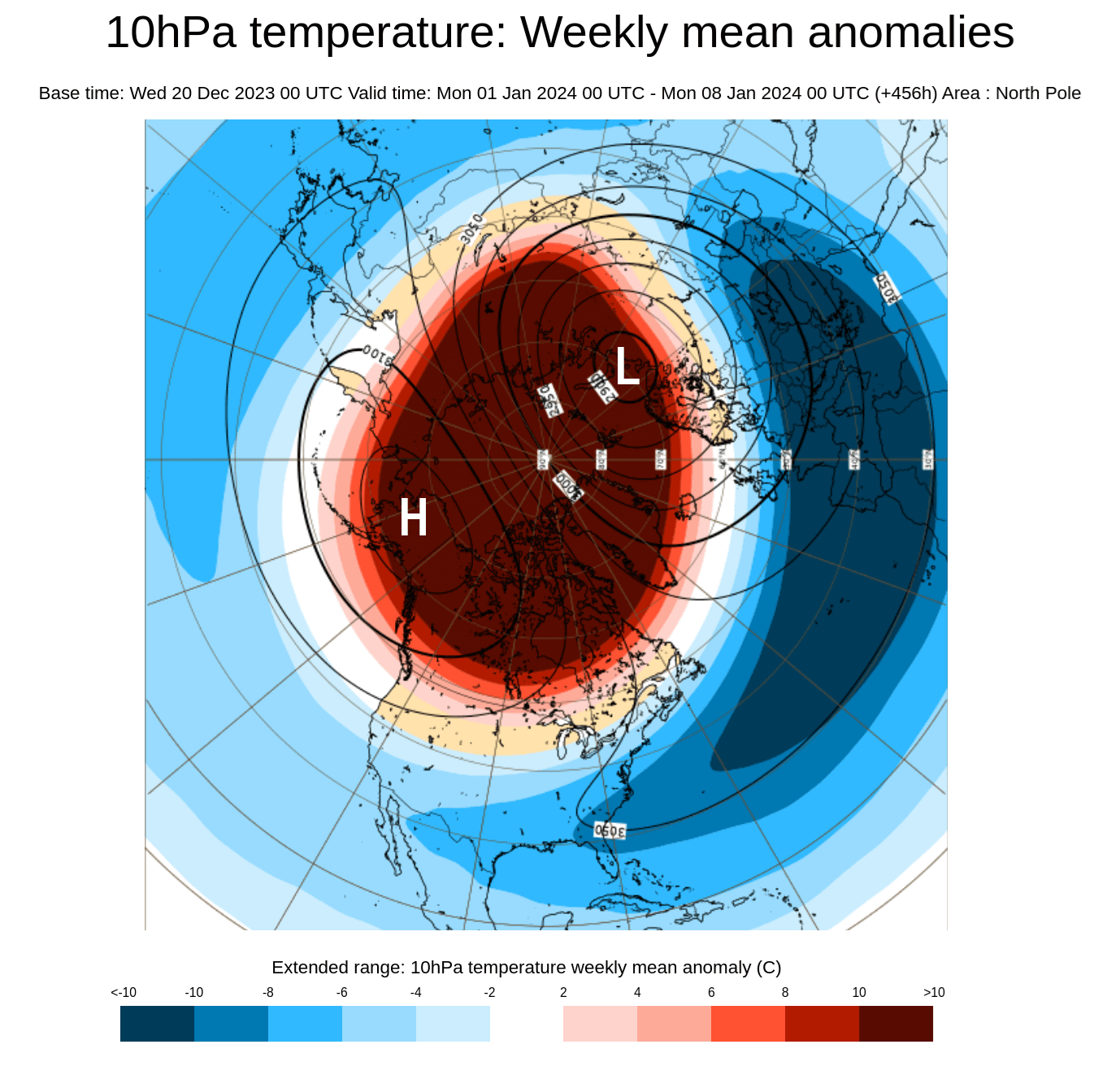
The GEFS model from the United States NCEP center also shows a substantial warming wave developing. In the image below, you can see the stratospheric temperature anomalies for early January. Inside the warming wave, you can find temperatures 40 (72F) degrees Celsius higher than normal for this time of year.
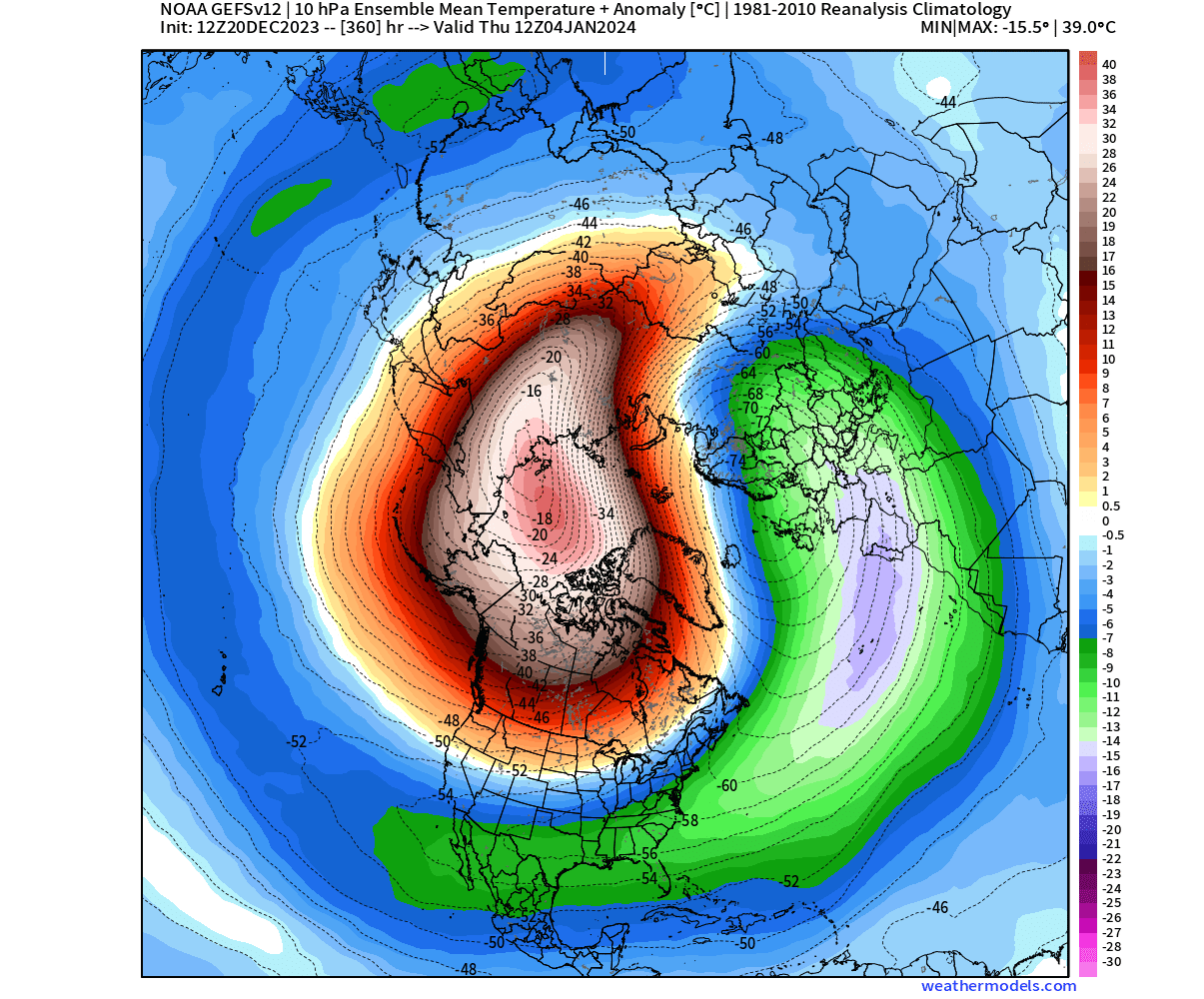
To add another model into the mix, we have the UKMO extended forecast. It shows the stratospheric wind speed forecast. It also shows a significant weakening of the polar vortex in early January.
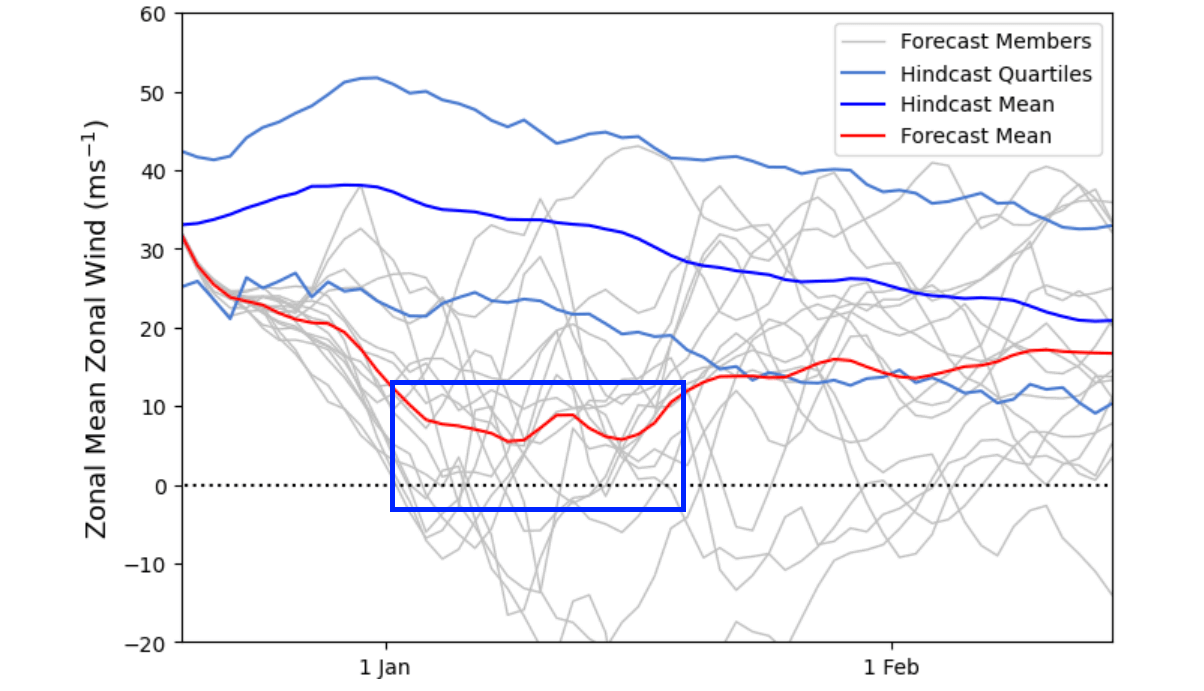
So, to recap, we have major signs from different forecasting systems that a major shift in the stratosphere is coming for the polar vortex. Based on what we know, a weak polar vortex has the power to substantially change the weather patterns across the United States and the rest of the Northern Hemisphere.
The stratospheric warming event is still many days away, and a full
wind reversal is not yet confirmed at the moment. But we will still look
at what we usually expect from stratospheric warming events and what
the latest forecasts show for early 2024.
MID-WINTER POLAR VORTEX COLLAPSE EVENT
Sudden Stratospheric Warming basically means a strong temperature and
pressure rise in the Stratosphere. That causes a major disturbance in
the circulation and, as a result, starts a collapse of the Polar Vortex.
Below, we have a typical vertical progression during a stratospheric warming event. You can see the main event in the stratosphere slowly affecting the surface layers below over a certain time period. In nature, it usually works in the way of the high-pressure anomalies coming down from the stratosphere to the surface.
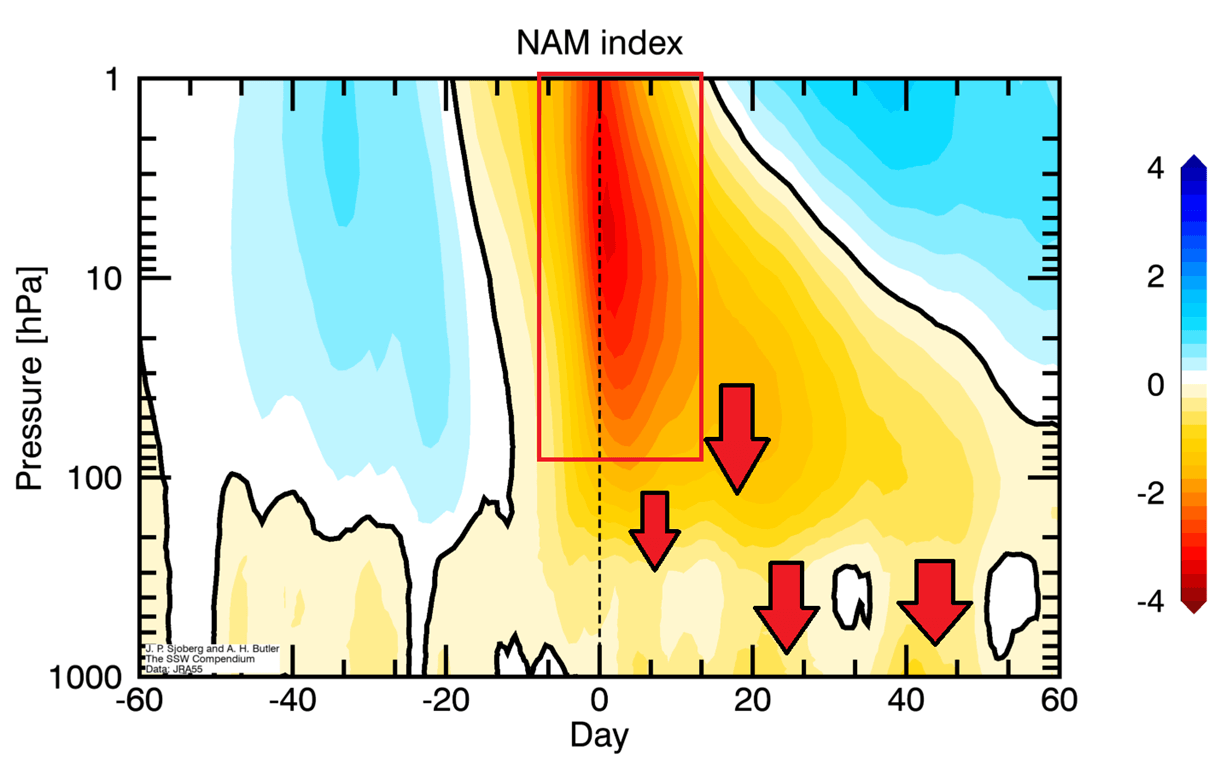
You can see the pressure patterns 0-30 days after a stratospheric warming in the image below. This is an average image of several different events, but it gives an idea of what we can usually expect. You can see the high-pressure area over the polar region.
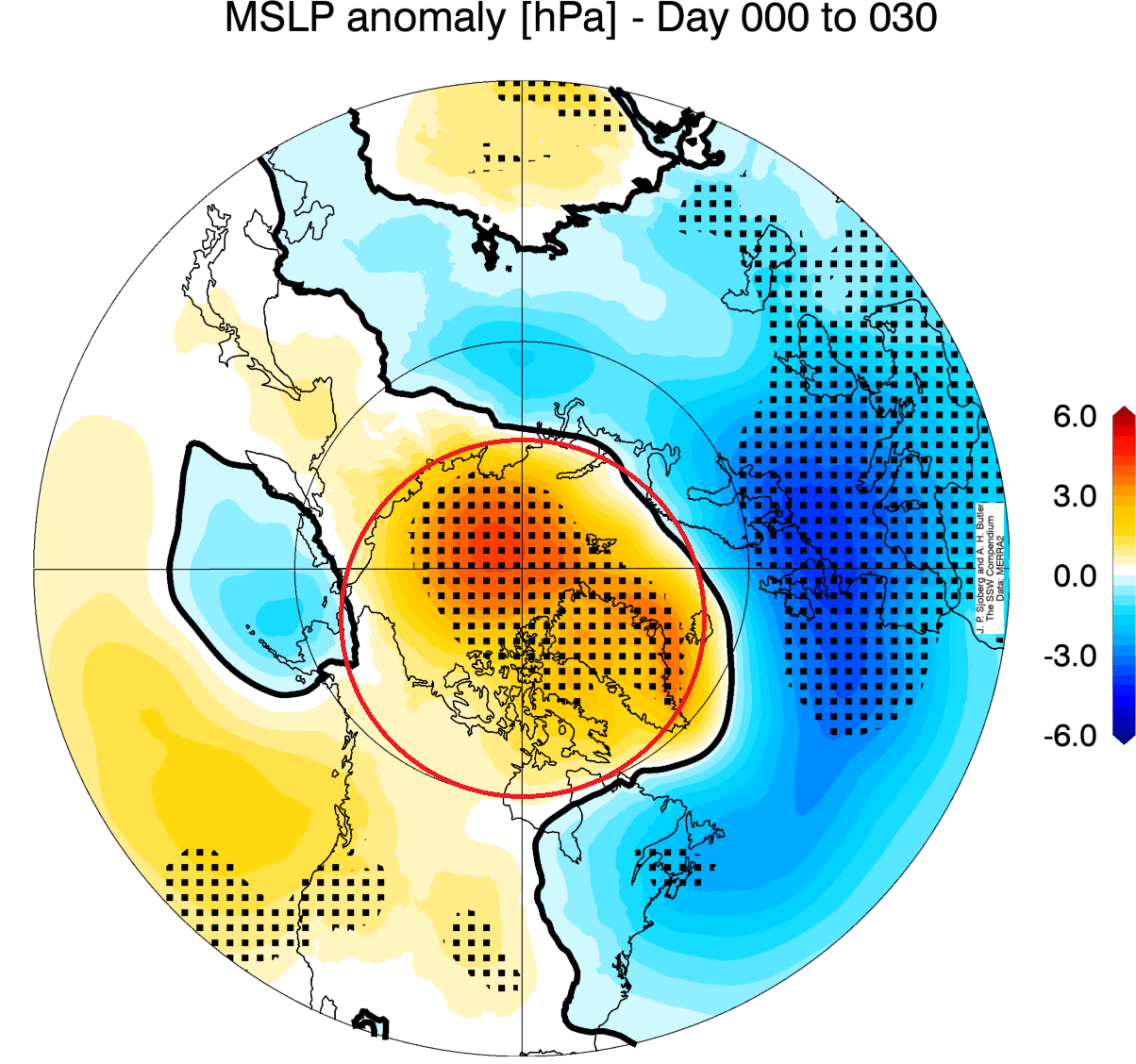
That means a weakened jet stream and low-pressure systems from the eastern United States across the North Atlantic and Europe. This helps to unlock the cold air from the Arctic, sending it towards the United States, as you can see in the image below.
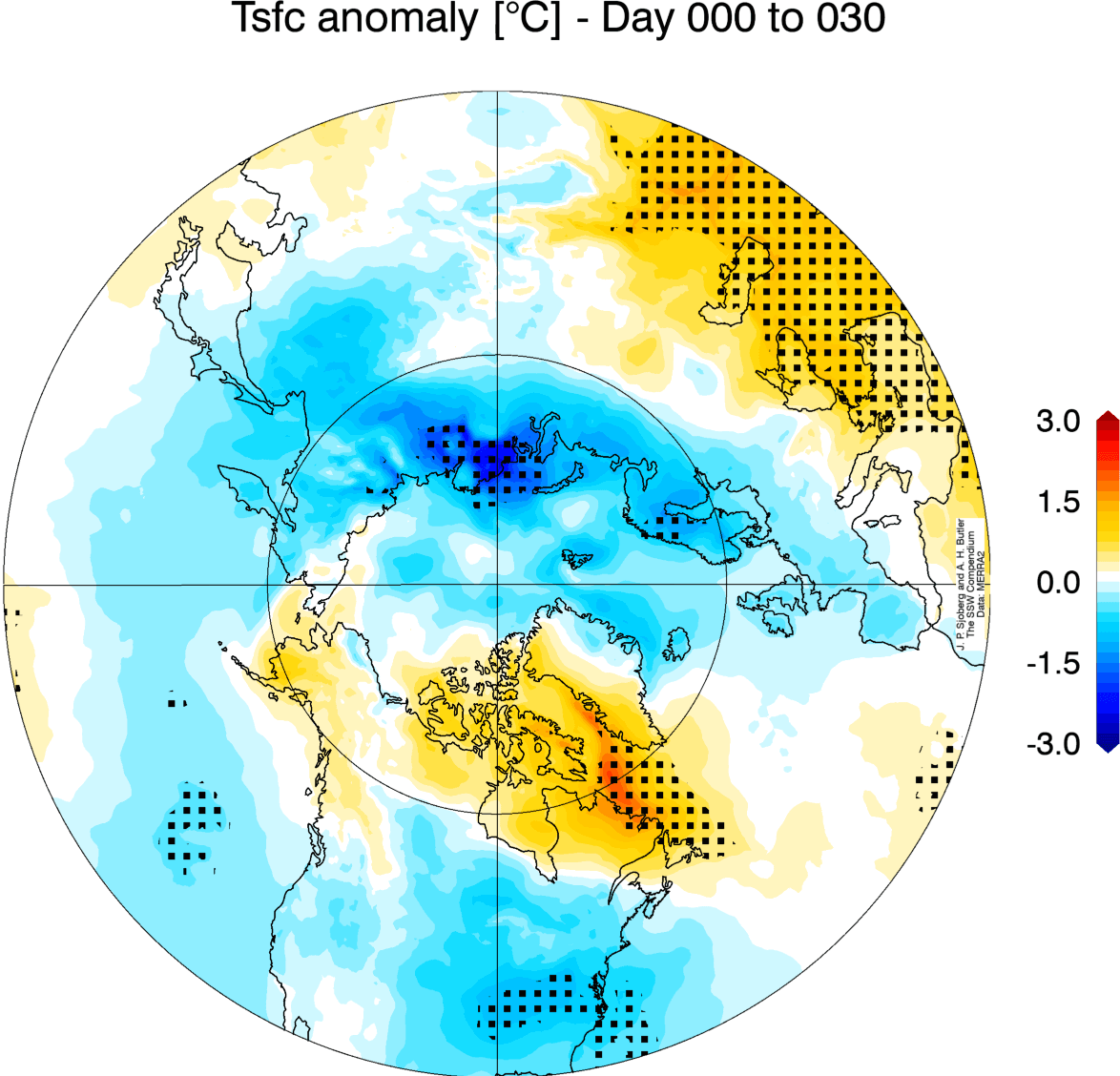
The images above show an average picture of many SSW events. Each stratospheric warming event is different and does not automatically mean a strong winter pattern.
So, what is currently shown in the weather pattern forecast for January?
NEW YEAR BRINGS WINTER WEATHER
We wrote two articles on the subject of weather pattern change in
January. The latest article will be linked below. But if we make a quick
summary, there were already early signs that a significant winter
pattern change is in the works for January.
The stratospheric warming event is one of the strong candidates (with El Niño) to help push the weather pattern into a more wintery mode.
Below is the surface pressure anomaly in the first half of January, by one of the extended forecasts. You can see an oddly strong resemblance to the surface pressure pattern we just showed above, following stratospheric warmings.
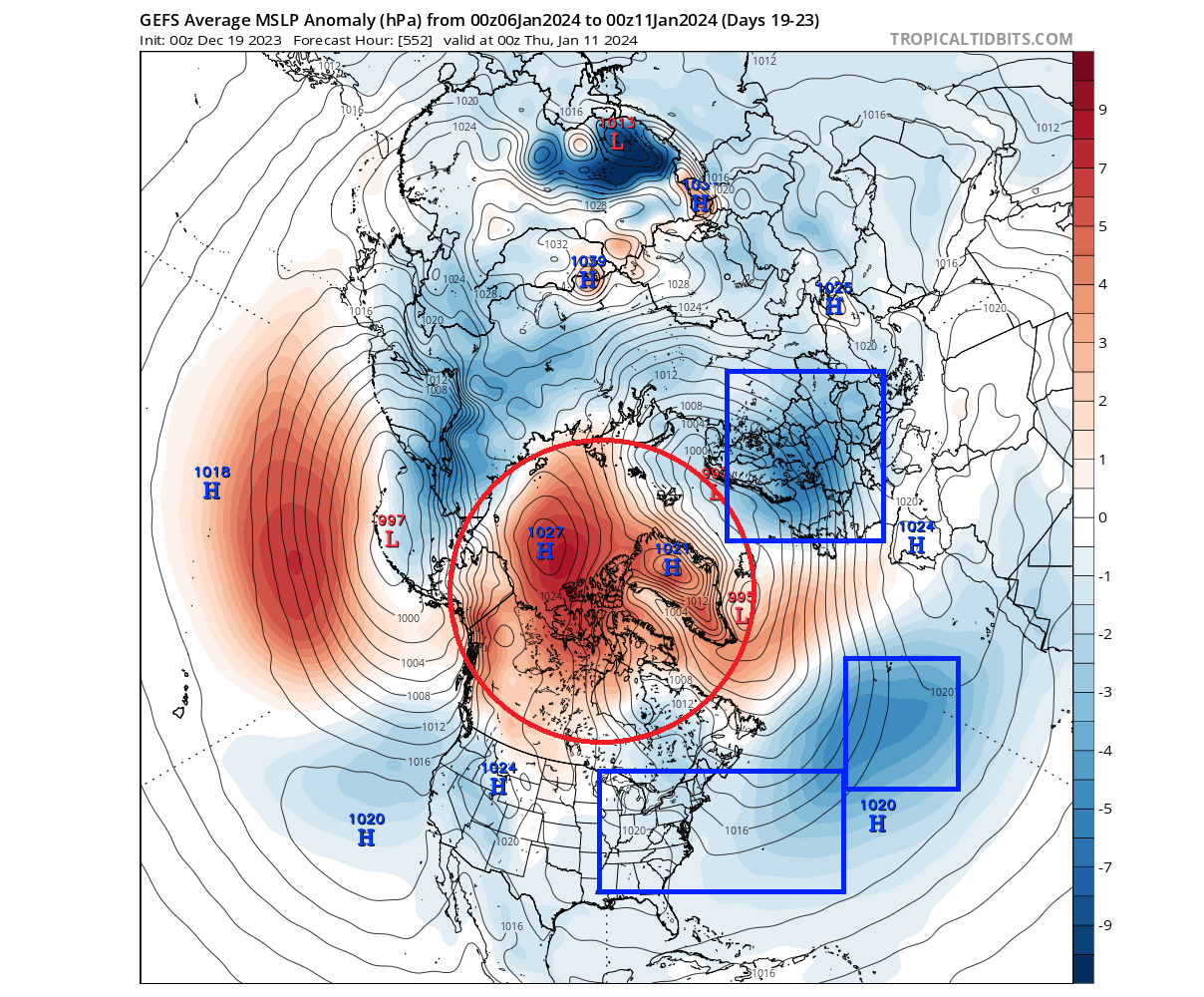
You can see the high-pressure over the pole and low-pressure areas over the United States, North Atlantic, and northern Europe. This is not necessarily a direct result of the stratospheric dynamics, but the whole system is connected and reflects changes from above to below and vice-versa.
The temperature pattern for this same period shows a colder anomaly over the United States, with a focus on the eastern United States. Such a temperature pattern would be expected after strong stratospheric dynamics.
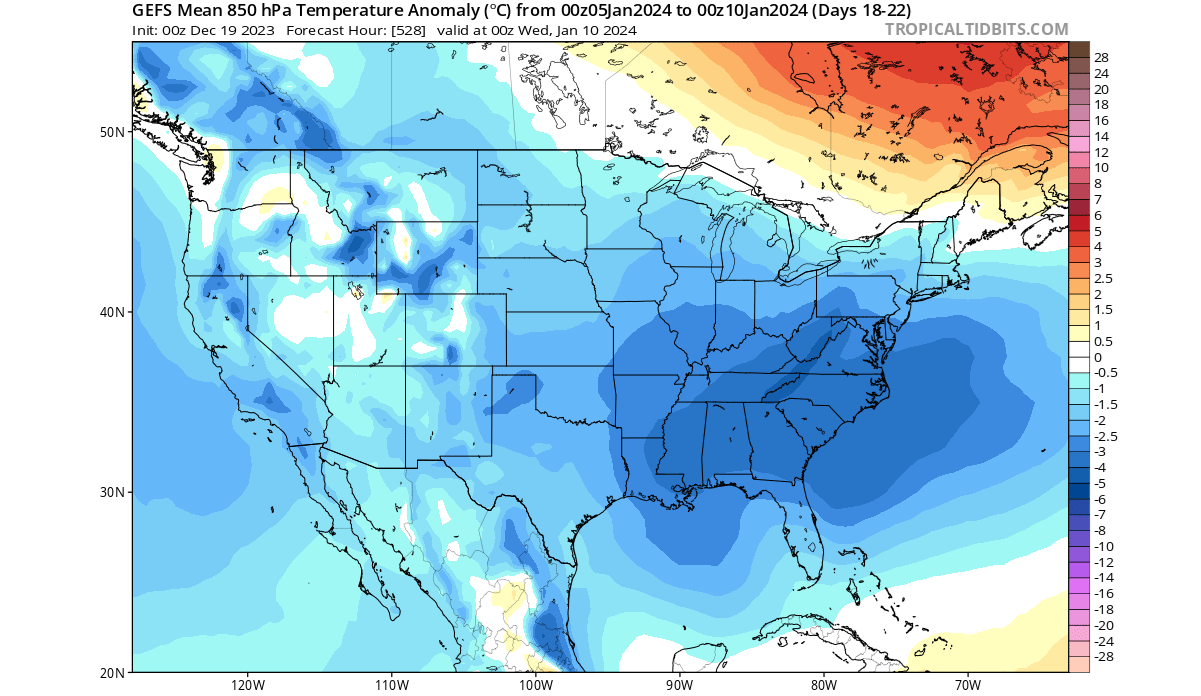
Over Europe, we do not see a major cold anomaly, but there is also no strong warm anomaly being forecast. With a high-pressure anomaly over the northern parts, a northerly flow can be expected at least towards mid-month if not sooner.
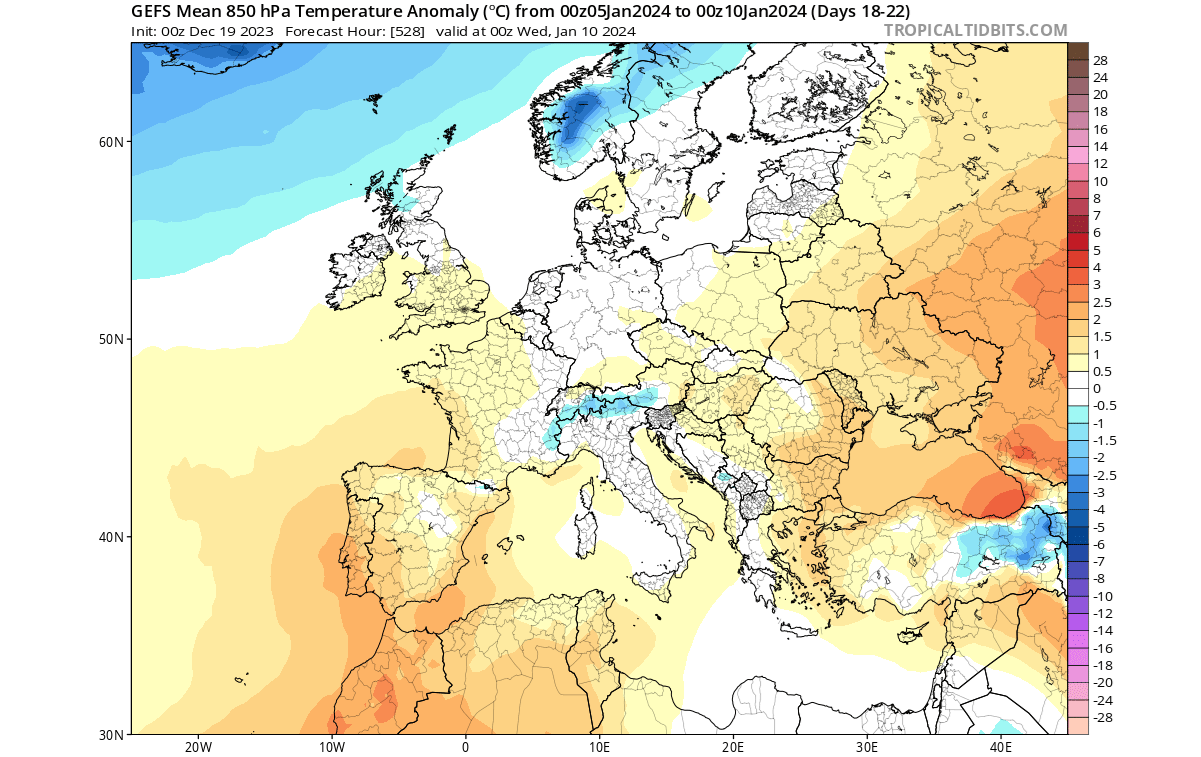
We also have to look at the ECMWF extended forecast, as it also shows strong stratospheric dynamics. Below is the pressure anomaly forecast for the second week of January, and you can nicely see the high-pressure area over the polar regions and low-pressure anomalies across the United States and Europe.
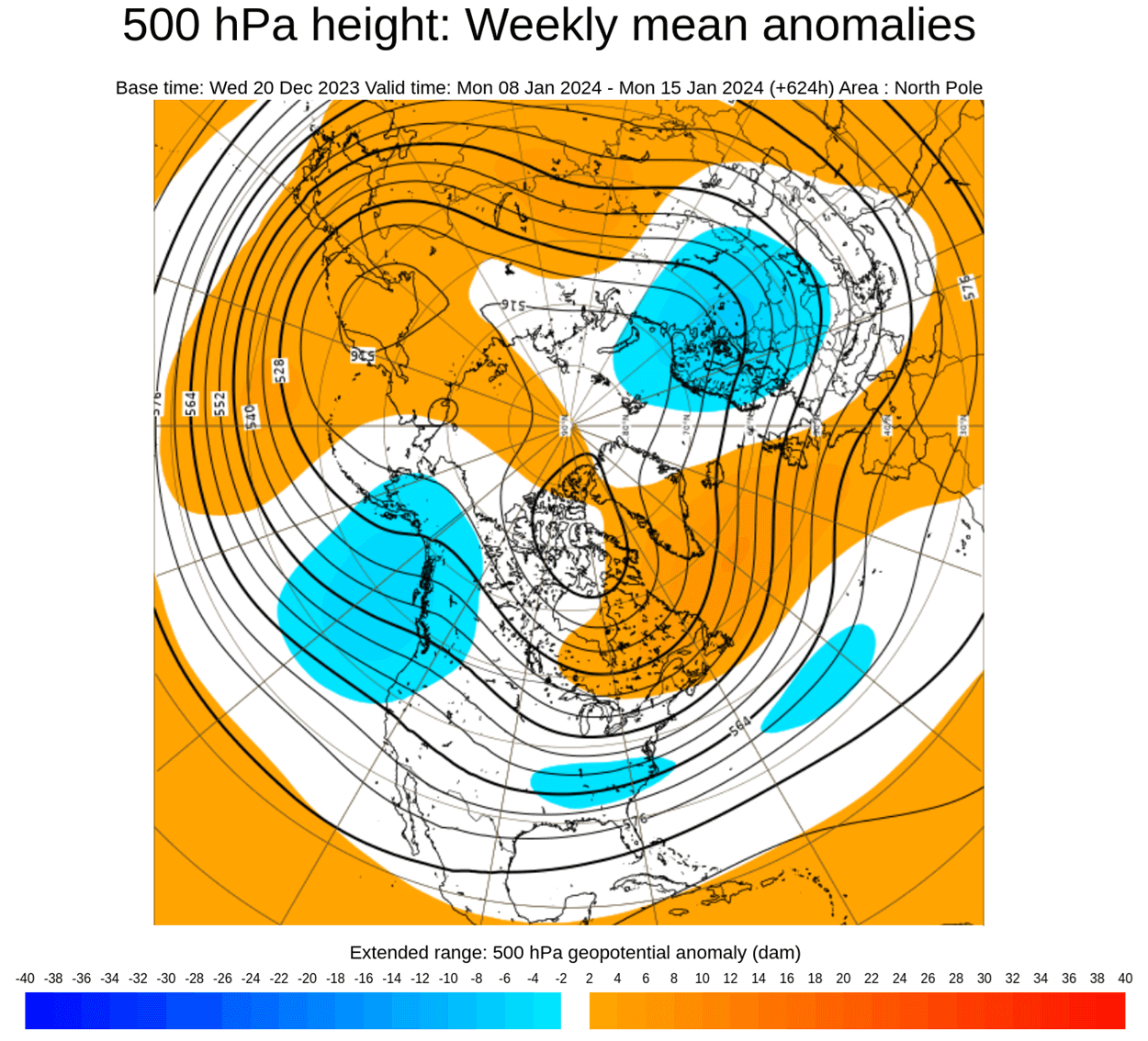
This indicates a weak vortex event and is consistent with the forecast of a strong warming event occurring in the stratosphere.
The surface temperature for the second week of January shows cold anomalies over the United States, with the exception of the upper Midwest. It is too early to talk specifically, but such a pattern would be supportive of some good winter weather across the eastern United States.
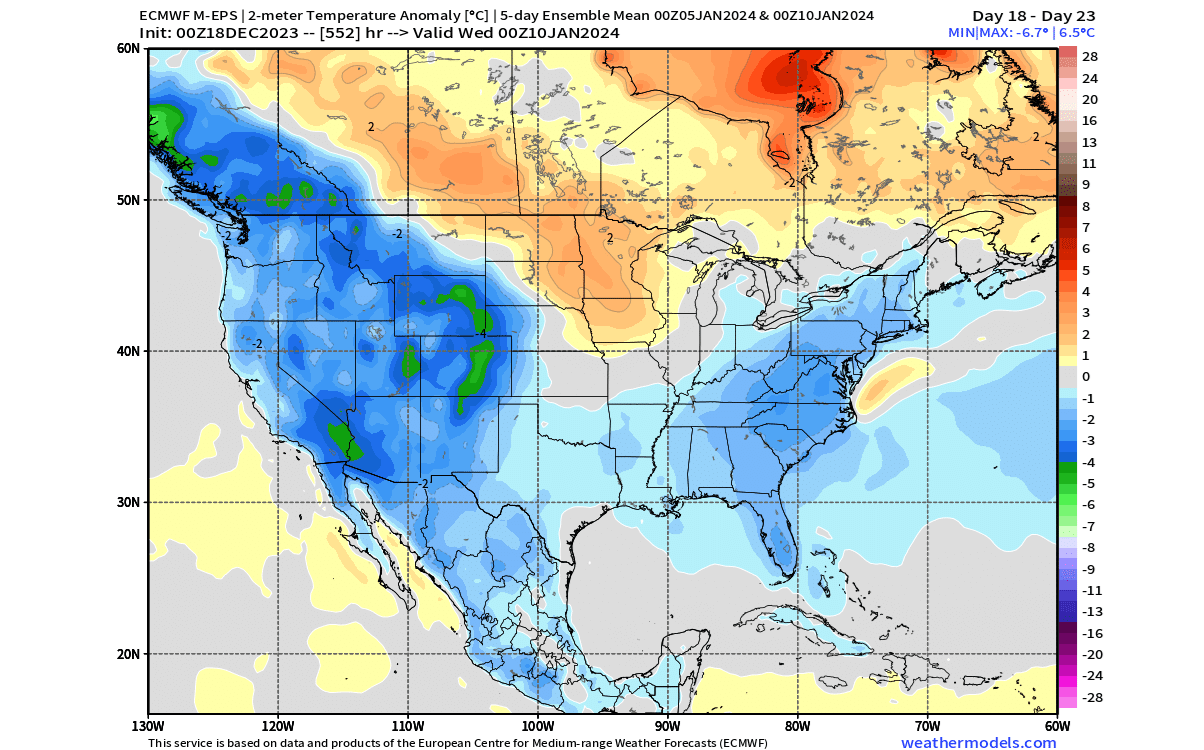
It is too early to talk specifics, as this is the extended forecasting range, so we are only looking at trends. But with everything considered, January is shaping up to show a completely different weather face compared to the much warmer December.
We will keep you updated on the global weather pattern development, so bookmark our page. Also, if you have seen this article in the Google App (Discover) feed, click the like button (♥) there to see more of our forecasts and our latest articles on weather and nature in general.
January weather pattern change: